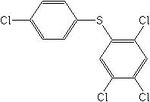Difference between revisions of "Tetrasul"
From Coastal Wiki
(New page: http://www.pesticideinfo.org/Detail_Chemical.jsp?Rec_Id=PC37170) |
Dronkers J (talk | contribs) |
||
| (14 intermediate revisions by 2 users not shown) | |||
| Line 1: | Line 1: | ||
| − | http:// | + | {{tocright}} |
| + | {{Definition|title=Tetrasul | ||
| + | |definition=Tetrasul, also known as diphenylsulphide, is a [[pesticide]] which was used against spider mites and aphids<ref name="IC">[http://sitem.herts.ac.uk/aeru/iupac/Reports/1275.htm#none International Union of Pure and Applied Chemistry: Pesticide Properties Database August 12 2009]</ref>. }} | ||
| + | |||
| + | == Notes == | ||
| + | |||
| + | {| class="toccolours" border="1" style="float: right; clear: right; margin: 0 0 1em 1em; border-collapse: collapse;" | ||
| + | ! bgcolor="#FF8888" | Tetrasul | ||
| + | |- | ||
| + | | align="center" bgcolor="#FFFFFF" | [[Image:Tetrasul.JPG|150px|tetrasul]] | ||
| + | |- | ||
| + | ! bgcolor="#8888FF" | Formula | ||
| + | |- | ||
| + | | align="center" | C<sub>12</sub>H<sub>6</sub>Cl<sub>14</sub>S | ||
| + | |- | ||
| + | |} | ||
| + | |||
| + | The use of tetrasul has been banned in Europe since 2003<ref>[http://eur-lex.europa.eu/LexUriServ/LexUriServ.do?uri=CELEX:32002R2076:EN:NOT European Directive 91/414/EEC]</ref>. | ||
| + | |||
| + | Tetrasul has a low water solubility (0.03 mg/l) and is very hydrophobic. It therefore is very likely to [[adsorption|adsorb]] to particles and the sediment and to have a high potential towards [[bioaccumulation]]. | ||
| + | |||
| + | Tetrasul becomes [[toxic]] for [[pollution and pelagic fishes|fishes]] at concentrations above 11 mg/l. As a substance witch bioaccumulates and possibly also [[biomagnification|biomagnifies]] there may be risks to [[pollution and marine mammals|marine mammals]] by secondary poisoning. Mammals which consume more than 3,9 g per kilogram of body weight might be affected. Chronic exposure might cause effects at lower doses<ref name="IC"/>. | ||
| + | <P> | ||
| + | <BR> | ||
| + | <P> | ||
| + | |||
| + | == Environmental standards and legislation == | ||
| + | |||
| + | [[OSPAR List of priority substances|Included in the OSPAR list of substances of priority action]] | ||
| + | <P> | ||
| + | <BR> | ||
| + | <P> | ||
| + | |||
| + | ==References== | ||
| + | <references/> | ||
| + | |||
| + | {{author | ||
| + | |AuthorID=19826 | ||
| + | |AuthorFullName=Daphnis De Pooter | ||
| + | |AuthorName=Daphnisd}} | ||
| + | |||
| + | [[Category:Toxicity chemicals]] | ||
Latest revision as of 13:37, 9 August 2020
Notes
| Tetrasul |
|---|

|
| Formula |
| C12H6Cl14S |
The use of tetrasul has been banned in Europe since 2003[2].
Tetrasul has a low water solubility (0.03 mg/l) and is very hydrophobic. It therefore is very likely to adsorb to particles and the sediment and to have a high potential towards bioaccumulation.
Tetrasul becomes toxic for fishes at concentrations above 11 mg/l. As a substance witch bioaccumulates and possibly also biomagnifies there may be risks to marine mammals by secondary poisoning. Mammals which consume more than 3,9 g per kilogram of body weight might be affected. Chronic exposure might cause effects at lower doses[1].
Environmental standards and legislation
Included in the OSPAR list of substances of priority action
References
Please note that others may also have edited the contents of this article.
|